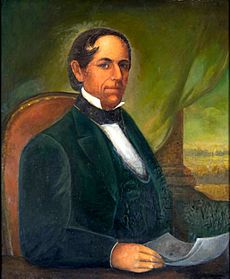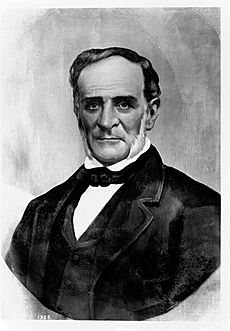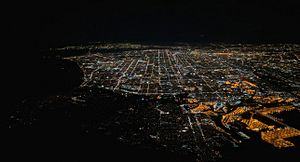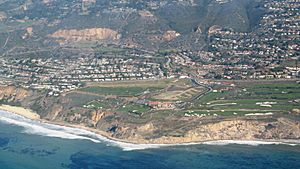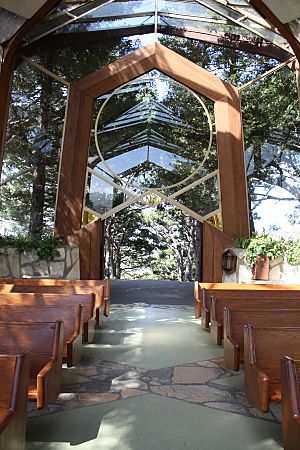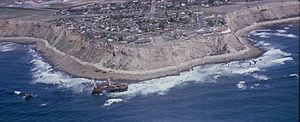Palos Verdes Peninsula facts for kids
Quick facts for kids
Palos Verdes Peninsula, California
|
|
|---|---|
|
Sub-region of the Los Angeles metropolitan area
|
|
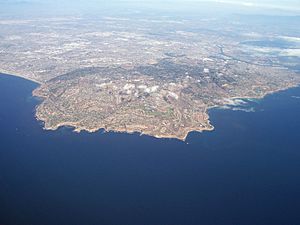
Aerial view of the Palos Verdes Peninsula and the Palos Verdes Hills, with Los Angeles city center in the distance
|
|
| Country | United States |
| State | California |
| County | Los Angeles |
| Area | |
| • Total | 37.5 sq mi (97 km2) |
| Population
(2010)
|
|
| • Total | 65,008 |
| Time zone | PST (UTC−8) |
| • Summer (DST) | PDT (UTC−7) |
| Area code(s) | 310/424 |
The Palos Verdes Peninsula is a beautiful area in Los Angeles County, California. Its name comes from Spanish words meaning "Green Sticks" or "Green Trees." It's part of the Los Angeles metropolitan area.
This peninsula is located in the South Bay region. It includes several cities like Palos Verdes Estates, Rancho Palos Verdes, Rolling Hills, and Rolling Hills Estates. The city of Torrance is to the north. The Pacific Ocean is to the west and south, and the Port of Los Angeles is to the east. In 2010, about 65,008 people lived here.
The cities on the peninsula are famous for their amazing views of the ocean and the city. They also have excellent schools, many horse trails, and beautiful homes.
Contents
History of Palos Verdes Peninsula
Early Native American Life

For thousands of years, the Tongva-Gabrieliño Native Americans called this peninsula home. Archeological sites in the wider Los Angeles area show people lived here as far back as 8,000 years ago. The first Europeans, led by João Cabrilho (Juan Cabrillo), arrived in 1542. Two important Tongva settlements on the peninsula were Chowigna and Suangna. The peninsula was also a starting point for their trips to the Channel Islands.
Spanish and Mexican Rule
In 1846, during the Mexican era, José Dolores Sepúlveda and José Loreto Sepúlveda received a land grant. This grant was for a piece of land from the much larger Rancho San Pedro. The new land was called Rancho de los Palos Verdes, meaning "ranch of the green trees." It was mainly used for raising cattle. For a short time in the mid-1800s, it was also used as a whaling station.
American Development
By 1882, the land was owned by Jotham Bixby, who rented it to Japanese farmers. In 1913, a wealthy investor named Frank Vanderlip bought 25 square miles of the peninsula for $1.5 million. He was amazed by the beautiful scenery, comparing it to famous places in Italy.
Vanderlip wanted to develop the area. He hired the famous Olmsted Brothers firm, known for their landscape design, to plan a new community. They started planning roads and landscaping. However, World War I began, and the project slowed down.
Later, in 1921, Vanderlip asked Edward Gardner Lewis to take over. Lewis was an experienced developer, but he needed a lot of money. He tried to raise funds by selling notes to investors, hoping to get $30 million for improvements. He only managed to get $15 million, which wasn't enough. So, the project went back to Vanderlip.
Vanderlip then created a new plan to develop 3,200 acres. This became the community of Palos Verdes Estates. Many improvements had already been made, like sewers, water pipes, roads, parks, and even a golf course. Palos Verdes Estates officially opened to the public in June 1923. The Olmsted Brothers made sure that about a quarter of the land was kept as open, undeveloped space.
Geography and Climate
The Palos Verdes Peninsula has a Mediterranean climate. This means it has warm, dry summers and mild, wet winters.
Shopping and Commerce
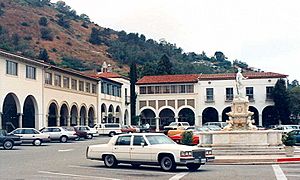
The peninsula has several places to shop and eat.
- Malaga Cove Plaza: This historic area has buildings in the beautiful Mediterranean Revival style.
- The Promenade on the Peninsula: This is a larger shopping center in Rolling Hills Estates. It has a movie theater and an ice rink.
- Peninsula Center: Another shopping area that used to have a department store.
- Lunada Bay Plaza** and **Golden Cove Plaza: These are smaller shopping centers.
The Palos Verdes area is known for its amazing views of the ocean, coastline, and city lights at night.
Getting Around (Transportation)
The Palos Verdes Peninsula Transit Authority provides bus service for people living on and visiting the peninsula. The peninsula is also close to two major airports: LAX and Long Beach Airport. Both are about 40 minutes away and offer flights to many places across the United States.
Education on the Peninsula
The Palos Verdes Peninsula Unified School District is highly rated. Its schools have some of the best test scores in California, including high average SAT scores. Many students also do well on Advanced Placement (AP) exams.
There are three high schools:
- Palos Verdes Peninsula High School
- Palos Verdes High School
- Rancho Del Mar High School
The peninsula also has 11 elementary schools and 3 intermediate (middle) schools. A private K–12 school called Chadwick School is located here. Rolling Hills Country Day School offers private education for grades K-8.
Some residents in the Eastview neighborhood can choose between Palos Verdes schools or schools in the Los Angeles Unified School District. Students can also attend the California Academy of Mathematics and Science in Carson, which is about 20-40 minutes away.
Libraries
The Palos Verdes Library District serves the area with three libraries:
- Peninsula Center Library
- Miraleste Library
- Malaga Cove Library (which is on the National Historical Register)
The "40 Families Project" at the Peninsula Center Library collects stories and information about the Japanese-American community that lived on Palos Verdes before World War II.
Parks and Recreation
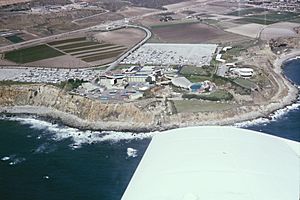
The Palos Verdes Peninsula offers many outdoor activities:
- South Coast Botanic Garden: This large garden covers 87 acres. It has over 150,000 plants and trees from many different families and species. It's a great example of how a former landfill and mine can be turned into a beautiful green space.
- Point Vicente Park: A popular spot for watching gray whales as they migrate to and from Baja California.
- Fort MacArthur Military Museum: Located near Point Fermin in San Pedro.
- Del Cerro Park: A popular place for hiking trails.
- Ryan Park: Rancho Palos Verdes' first park, with views of Santa Catalina Island. It has baseball fields, picnic areas, and a community room.
The peninsula is a favorite place for runners, hikers, horseback riders, bird watchers, surfers, scuba divers, fishermen, and bicyclists. There are also several golf courses and country clubs.
Some surf spots in Palos Verdes, like Lunada Bay, have had issues with local surfers trying to keep others out. In 2016, a structure built along Lunada Bay was removed after reports of it being used for intimidation.
The Trump National Golf Club has a golf course on the Ocean Trails cliffs. The 18th hole of the previous course was damaged by a landslide.
The site of the former Marineland of the Pacific aquatic park is now Terranea, a luxury oceanfront resort.
There are also many nature reserves on the peninsula, such as Palos Verdes Estates Shoreline Preserve, Agua Amarga Reserve, and Portuguese Bend Reserve. These reserves protect coastal sage scrub habitats, which are home to many fragrant and drought-resistant plants. In 2009, a wildfire burned part of the Portuguese Bend Reserve, and efforts have been made to restore native plants and animals there.
Plants and Animals (Flora and Fauna)
Native Plants
- Succulents
- Trees
- Shrubs
- Vines
- Herbaceous plants (plants with soft stems)
- Marah (plant) (wild cucumber)
Native Animals
- Palos Verdes blue butterfly (an endangered species)
- Opossum
- Gray fox
- Coyote
- Black phoebe (a type of bird)
- Water strider (an insect that walks on water)
- Western fence lizard
- Red tailed hawk (a bird of prey)
- Cottontail rabbit
Interesting Places to Visit
- The Wayfarers Chapel: This unique chapel, designed in 1951 by architect Lloyd Wright, is made of transparent glass and surrounded by a redwood forest. It's a famous landmark on the National Register of Historic Places and overlooks the ocean.
- Portuguese Bend: This area is known for its constantly shifting soil and rock slides. This means the main road, Palos Verdes Drive South, needs frequent repairs.
- Point Vicente Lighthouse: This historic lighthouse is also on the National Register of Historic Places.
- Korean Bell of Friendship: Located near Point Fermin in San Pedro.
- Marineland of the Pacific: This was once a popular aquatic theme park on the coast.
- MTV Beach House: Some scenes from the TV show The OC were filmed in and around Palos Verdes.
Shipwrecks
- SS Dominator: This freighter ran aground in 1961. For many years, its remains were a popular spot for hikers. Today, very little of the ship is left.
- In 2006, a 45-foot boat called Lady Hawk sank off the coast due to an engine fire.
Famous People from Palos Verdes
|
See also
 In Spanish: Palos Verdes para niños
In Spanish: Palos Verdes para niños
- Horse community
- Palos Verdes blue—an endangered species of butterfly found only on the Palos Verdes Peninsula
- Palos Verdes Peninsula Land Conservancy
- Peninsula—a piece of land almost surrounded by water
- Transverse Ranges—a mountain range that includes the Palos Verdes Hills


